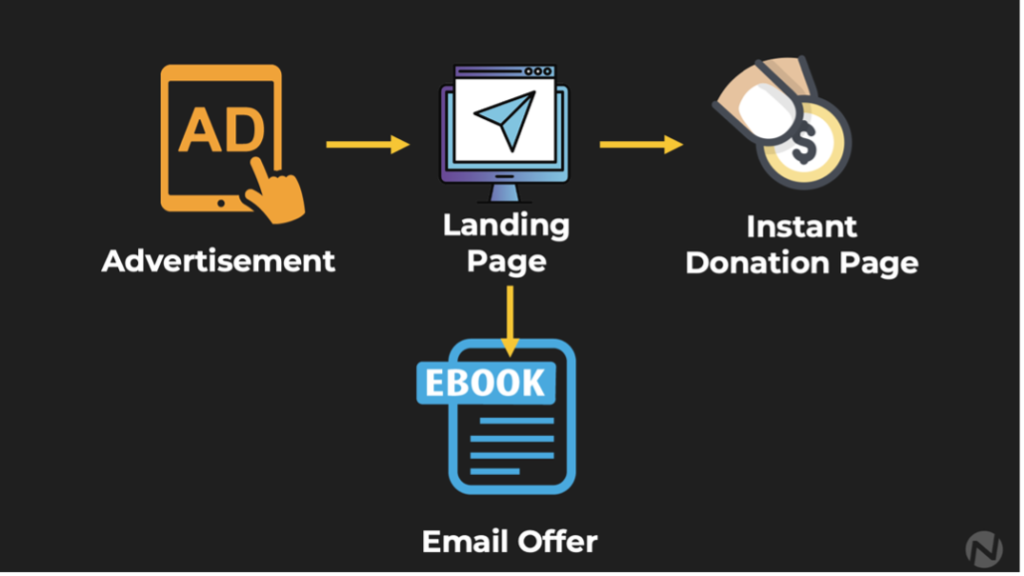
42% of nonprofits report problems with integrating marketing, fundraising, and finance.
This is according to an executive study of 155 nonprofits benchmarking their marketing, fundraising, and communication practices. This lack of integration leads to wasteful spending, unnecessary complexity, and inefficient results.
Without integrated marketing and fundraising teams, you’ll have conflict between teams and mis-aligned goals. And if your teams’ goals conflict with one another, how can you expect them to achieve success?
Moreover, in my own personal experience, teams with conflicting goals and directions can lead to employee burnout. If that happens…then you have an even bigger problem on your hands.
A Tale of Two Silos: Marketing and Fundraising
Traditionally, a marketing team’s primary goal is to generate demand that leads to sales.
In the nonprofit context, you can swap in the word “donations” for “sales.” This gives a clear path from reaching new people, to converting them into donors, and retaining their support long term.
With an integrated approach, marketing generates leads that are ideal donor prospects, they’ve been cultivated well, and are primed to have high trust in your organization.
When fundraising swoops in with their next campaign, they have high-value prospects to present with a meaningful appeal. And these prospects are ready to say yes to giving.
This is the ideal pipeline. But as you know, it’s not always the reality. Very rarely is there a clear path from marketing to fundraising.
Siloed Marketing Teams Don’t See the End Goal
A siloed marketing team doesn’t have their eyes set on donations or revenue. Without an eye on donations, most marketing teams focus on what I would deem as “superficial” metrics.
Marketing often focuses on metrics like:
- Number of impressions
- Total reach
- Video views
- Time on site
- Email clicks
Each of these metrics have a proper time and place, but they’re not the end goal.
Even if marketing is focused on a more substantial metric like “email acquisition”, it’s often divorced from the ultimate goal of donations. And this can be problematic for the fundraising team.
For example, one very common “offer” that marketers use to acquire new emails is free giveaways: win a trip, win free tickets, win a prize pack, etc.
Free giveaways can be very attractive and lead to a high-volume of “leads.” But the quality of those leads can end up being extremely poor. Many people signing up for free contests provide a “junk” email address that often goes un-monitored.
Even if you get a mailable email address, your contest or giveaway does nothing to build trust with the potential donor. What happens to all the people who don’t win your contest? How are they taking meaningful next steps with your organization? How is a relationship being cultivated?
If there’s no relationship or cultivation, it’s going to make life hard for the fundraising team to acquire new donors.
Siloed Fundraising Teams Don’t Have the Tools They Need
An effective fundraising team needs the content, distribution, and technical skills that are often housed in marketing. But a siloed team doesn’t have access to these critical resources.
We’ve found that one of the most effective tools for acquiring a new donor is free content: petitions, surveys, ebooks, online courses, etc. In fact, a free content offer like an ebook can be simple to create and can lead to upwards of 3% of leads becoming donors.

This type of content is typically housed in the marketing department. And in a siloed team, it doesn’t get used for fundraising purposes.
As a result, a fundraising team flounders to try and cultivate potential and existing donors. They need to send more email communication. They need to keep donors connected to content. They need content that connects donors to the impact.
A siloed team is left to their own devices to create cultivation out of nothing – and often without a means of consistently distributing content to their donors in mass.
Integration Leads to Revenue Generation
The good news for you is that there is a different way forward. And the payoff of integrating marketing and fundraising goals and tactics is substantial.
In fact, the most sustainable means of acquiring new donors that we have unlocked over years of testing requires the integration of both marketing and fundraising skillsets:
- High quality content (often created by marketing teams)
- A highly effective value proposition (often developed by the fundraising team)
Without high quality content, potential donors won’t be cultivated and primed for a donation appeal. And without a highly effective value proposition, even the most cultivated leads won’t see a clear reason to give.
An Integrated Donor Acquisition Model
The most sustainable donor acquisition model that we’ve uncovered through testing relies on 4 key ingredients:
- Advertising (or traffic generation)
- A content offer (free content for someone to consume)
- A landing page (with a form for someone to access the content offer)
- An instant donation page (with a donation appeal and form right on the page)

In short, you must find more of the right people using advertising. That advertising should point potential donors towards valuable content. That content should build their trust in your organization. And finally, they need clear and strong reasons to give on the instant donation page.
You can read a full breakdown of this online donor acquisition model here, but the main takeaway for you today is this: the path to grow your donations, revenue, and impact lies with an integrated approach.

Get more insights for nonprofit executives
Want to see what else we learned from benchmarking the fundraising, marketing, and communications practices of 155 nonprofits?
You can get access to the full Nonprofit Fundraising Executive Benchmark Report for free here.



